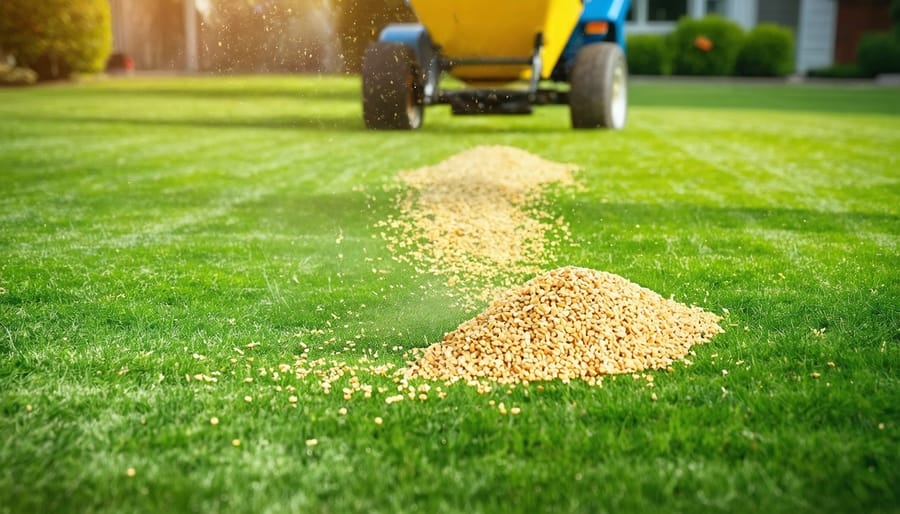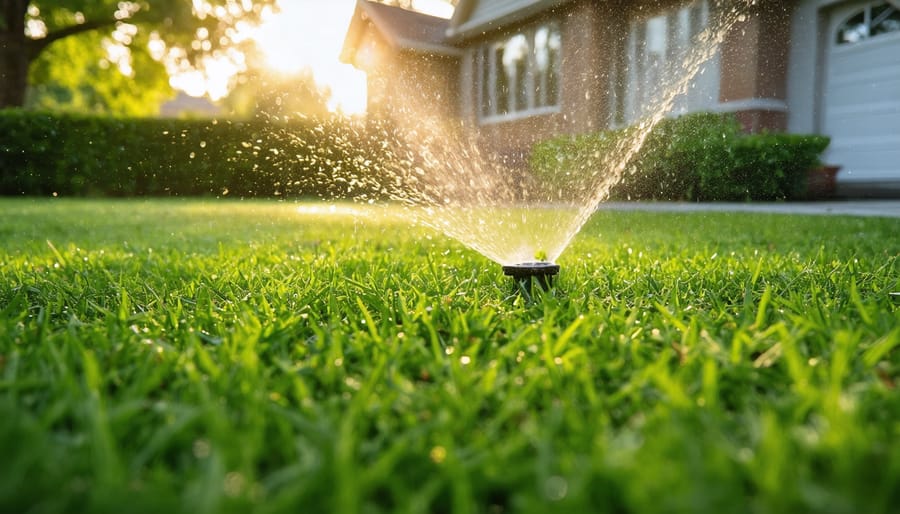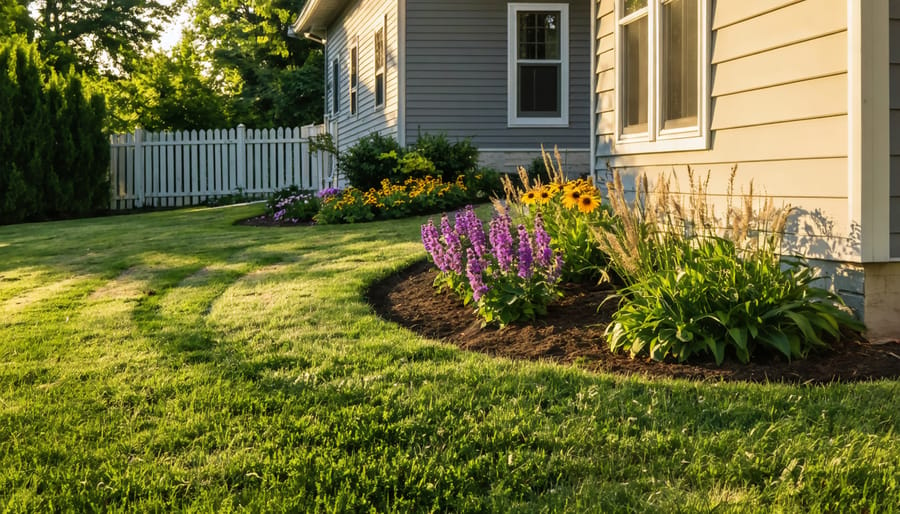Apply a high-quality fall fertilizer with elevated potassium levels between late August and October to strengthen root systems before winter dormancy, giving your lawn the nutrient foundation it needs to survive freezing temperatures and emerge vibrant in spring. The autumn feeding window is your single most powerful opportunity to build lawn resilience, as grass naturally channels energy downward during cooler months rather than into blade growth.
Aerate compacted soil in early fall when grass actively grows, creating channels for oxygen, water, and nutrients to penetrate deep into the root zone where they matter most. This simple mechanical process reverses months of foot traffic damage and prepares your lawn to absorb treatments effectively.
Overseed thin or damaged areas immediately after aeration while soil temperatures remain above 50°F, taking advantage of reduced weed competition and ideal germination conditions that autumn naturally provides. Cool-season grasses particularly thrive when established during this period, filling gaps before winter weeds claim the territory.
Target fall pest prevention by applying appropriate treatments for grubs, which feed aggressively on roots during autumn months before burrowing deeper for winter. Left unchecked, these hidden destroyers create brown patches that won’t recover until you’ve invested significant time and money in spring repairs.
The difference between lawns that merely survive winter and those that thrive comes down to intentional autumn preparation. While neighbors scramble with expensive spring renovations, your properly treated lawn will green up faster, resist disease better, and require fewer interventions throughout the growing season. Fall treatment isn’t just maintenance—it’s an investment that compounds returns for years.
What Happens to Your Lawn in Autumn (And Why It Matters)
As the days grow shorter and temperatures begin to dip, your lawn undergoes a fascinating transformation that’s largely invisible to the casual observer. Understanding what’s happening beneath the surface can completely change how you approach autumn lawn care and set you up for a gorgeous, healthy lawn come spring.
During autumn, your grass shifts its energy priorities in a pretty remarkable way. While the visible top growth slows down considerably, the roots enter a period of vigorous development. This makes perfect sense from the plant’s perspective: cooler air temperatures combined with still-warm soil create ideal conditions for root expansion without the stress of summer heat. Your grass is essentially banking resources underground, building a robust root system that will support healthy growth when spring arrives.
The cooler temperatures also enhance your lawn’s ability to absorb and store nutrients. Think of it as your grass preparing for a long winter’s rest by stocking up the pantry. The metabolic processes that govern nutrient uptake actually become more efficient in the 50-65°F temperature range typical of autumn. This is precisely why autumn fertilization is so effective compared to other times of year.
Soil activity shifts during fall as well. Beneficial microorganisms remain active in the moderate temperatures, continuing to break down organic matter and make nutrients available to grass roots. Meanwhile, the combination of autumn rainfall and reduced evaporation means your lawn can absorb water more effectively without the constant battle against drought stress.
Perhaps most importantly, autumn recovery time allows your lawn to repair summer damage without immediately facing new challenges. Those worn patches, heat-stressed areas, and thin spots have a golden opportunity to fill in and strengthen. Your grass is working hard to fortify itself before winter dormancy sets in, making autumn treatment less about immediate cosmetic results and more about investing in long-term lawn health and resilience.
The Essential Autumn Lawn Conditioning Steps
Aeration: Opening Up Your Soil for Success
Think of your lawn as needing to breathe, just like you do after a long day. Over time, foot traffic, mowing, and natural settling compress your soil, creating a dense layer that prevents air, water, and nutrients from reaching grass roots. This compaction is one of the biggest hidden culprits behind lackluster lawns, and autumn is the perfect time to address it.
Compacted soil creates a hostile environment for grass. Roots struggle to penetrate deeply, making your lawn vulnerable to drought stress and disease. Water pools on the surface rather than soaking in, and beneficial microorganisms can’t thrive without adequate oxygen. The result? Thin, patchy grass that never quite looks its best, no matter how much you water or fertilize.
Autumn aeration works beautifully because grass is actively growing and can quickly recover from the process. Aim to aerate in early to mid-autumn when soil moisture is ideal—not too wet, not too dry. If you can easily push a screwdriver six inches into your lawn, conditions are right. Avoid aerating during drought or when the ground is waterlogged.
For smaller lawns, manual aerating tools with hollow tines work well and provide good exercise. These remove plugs of soil, creating channels for air and water. For larger areas, consider renting a mechanical core aerator or hiring a local service. Look for machines that remove cores rather than just punching holes, as core aeration is far more effective.
Here’s a sustainable tip: leave those soil plugs on your lawn. They’ll break down naturally within a few weeks, returning valuable microorganisms to your soil. After aerating, your lawn is primed to absorb autumn fertilizer and overseed treatments, making this the foundation of successful fall lawn care.
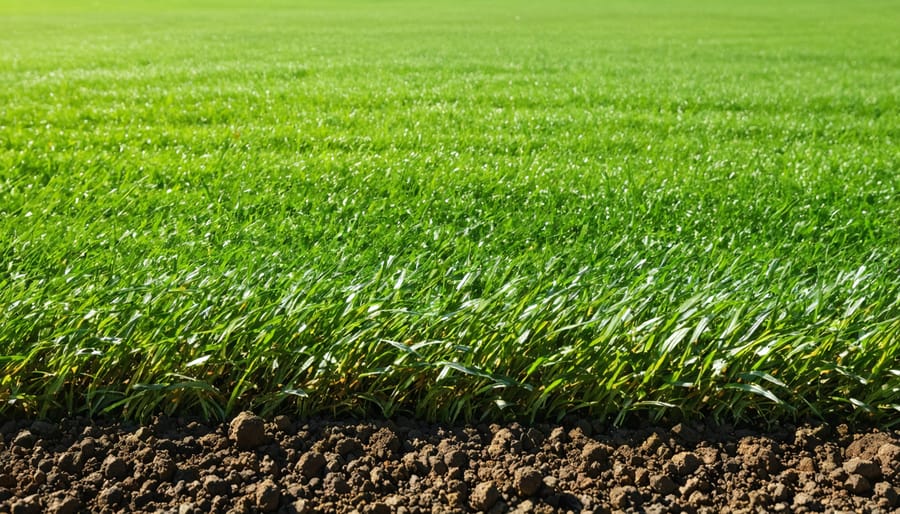
Overseeding to Fill in Bare Spots
Fall is hands-down the best season for overseeding your lawn, and here’s why: cooler temperatures, morning dew, and usually more consistent rainfall create perfect conditions for grass seed germination. Plus, those pesky weeds that compete with new grass in spring are mostly dormant now, giving your seedlings a fighting chance to establish strong roots before winter.
The secret to successful overseeding starts with choosing the right grass variety for your region. Cool-season grasses like perennial ryegrass, tall fescue, and Kentucky bluegrass thrive when seeded in autumn across northern climates. If you’re in a transitional zone, consider mixing varieties for better adaptability. Visit your local extension office or garden center for regionally-tested recommendations that suit your specific conditions.
Here’s a game-changing tip: coordinate your overseeding with aeration for dramatically better results. Those freshly-punched holes create ideal pockets for seeds to nestle into, ensuring excellent seed-to-soil contact while protecting them from hungry birds. If you’re planning both tasks, aerate first, then overseed within 48 hours while the soil is still loose and receptive.
For technique, aim for even coverage using a broadcast spreader, applying about half the recommended rate in one direction, then the other half perpendicular to your first pass. This prevents streaky results and ensures consistent coverage. Lightly rake the area to help seeds settle into the aeration holes and exposed soil.
Understanding proper seeding timing makes all the difference. Schedule your overseeding about 45 days before your first expected frost to give seedlings adequate establishment time. Keep the seeded area consistently moist for the first two to three weeks, watering lightly once or twice daily until you see healthy germination.

Fertilizing for Root Strength (Not Top Growth)
As summer fades, your lawn’s needs shift dramatically. While spring and summer fertilizers focus heavily on nitrogen to promote lush, green top growth, autumn feeding takes a completely different approach. Think of it as helping your lawn build a strong foundation rather than showing off its good looks.
During fall, you want to encourage robust root development and help your grass store energy reserves for winter survival. This means choosing fertilizers with higher phosphorus and potassium content relative to nitrogen. Look for formulations with an NPK ratio like 5-10-10 or similar, where those last two numbers are noticeably higher than the first. Phosphorus strengthens roots and helps plants transfer energy efficiently, while potassium improves disease resistance and overall hardiness.
Timing matters tremendously here. Your September feeding strategies should begin as temperatures start cooling but while grass is still actively growing. For most regions, this means late September through October. Apply fertilizer when rain is expected within a day or two, or water thoroughly after application to help nutrients reach the root zone.
For sustainable options, consider slow-release organic fertilizers containing bone meal for phosphorus and kelp meal or wood ash for potassium. These release nutrients gradually, reducing runoff and feeding soil microorganisms that support long-term lawn health.
Application rates should follow package directions carefully, but generally autumn feeding requires less product than spring applications. Over-fertilizing in fall can actually weaken grass by promoting tender growth that won’t survive winter’s harsh conditions.
Autumn Pest Prevention: Stop Problems Before They Start
Common Fall Lawn Pests and Their Warning Signs
As temperatures cool and leaves begin to fall, your lawn faces a unique set of challenges from pests that actually thrive in autumn conditions. The good news? Catching these troublemakers early makes all the difference in protecting your turf through winter and into spring.
Let’s start with grubs, those plump, C-shaped larvae that feast on grass roots beneath the surface. If you notice irregular brown patches that peel back like loose carpet, you’ve likely got grubs at work. They’re most active in early fall, and you can confirm their presence by lifting a section of damaged turf—finding more than five grubs per square foot signals a problem worth addressing. The damaged areas often attract animals like skunks and raccoons who dig up your lawn for an easy meal.
Chinch bugs present differently. These tiny black insects with white wings create yellowing patches that gradually expand outward, often mistaken for drought stress. They prefer sunny areas and cause damage by sucking plant juices from grass blades. Look closely at the border between healthy and damaged grass on a warm afternoon—you’ll spot these little pests scurrying about.
Armyworms, true to their name, move across lawns in groups, leaving closely cropped, irregular brown patches in their wake. They’re most active at dusk and dawn, and you might notice birds congregating on your lawn, feasting on these caterpillar-like pests.
Don’t overlook fungal diseases either. Fall’s combination of warm soil and cool, moist air creates perfect conditions for brown patch and dollar spot. Brown patch appears as circular areas of brown grass with a darker outer ring, while dollar spot creates small, silver-dollar-sized tan patches. Both spread quickly in humid conditions, making early identification crucial for effective treatment.
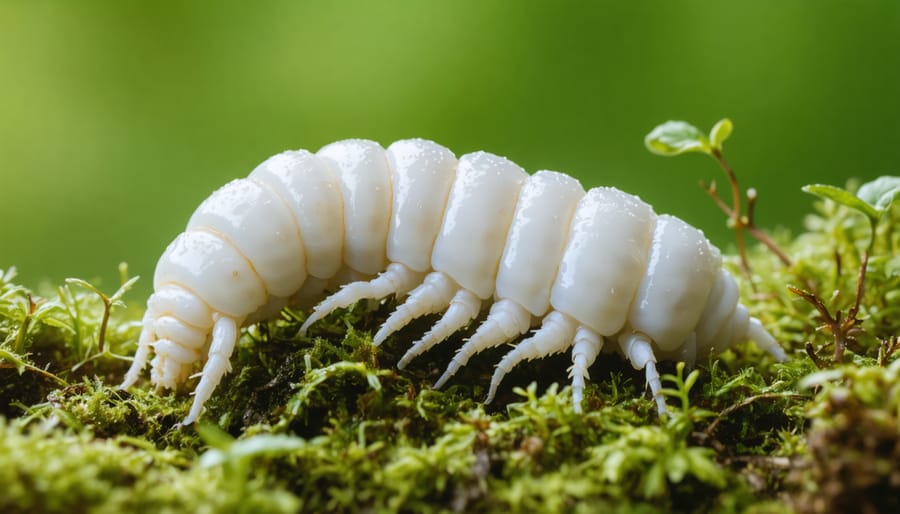
Eco-Friendly Pest Prevention Strategies
As autumn arrives, it’s the perfect time to implement pest prevention strategies that work with nature rather than against it. I’ve found that taking a proactive, eco-friendly approach in fall pays dividends come spring, keeping both pests and diseases at bay without harsh chemicals.
Let’s start with one of my favorite allies: beneficial nematodes. These microscopic organisms are absolute champions at controlling soil-dwelling pests like grubs, which can wreak havoc on grass roots during their feeding frenzy. Simply mix these helpful creatures with water and spray them onto your lawn in early autumn when soil temperatures are still above 50 degrees Fahrenheit. They’ll hunt down grub larvae and other unwanted guests, providing protection that lasts through winter. The best part? They’re completely harmless to earthworms, pets, and people.
Your watering schedule plays a surprisingly significant role in pest and disease prevention. Rather than frequent shallow watering, aim for deep, infrequent watering sessions early in the morning. This approach allows grass blades to dry before evening, reducing the risk of fungal diseases that thrive in damp, cool conditions. As temperatures drop, you can gradually reduce watering frequency since cooler weather means less evaporation and slower growth.
Maintaining the right mowing height is another simple yet effective strategy. Keep your grass at about 2.5 to 3 inches throughout autumn. This height is tall enough to shade out weed seeds trying to establish themselves but short enough to prevent matting under fallen leaves, which can create ideal breeding grounds for pests and diseases.
Finally, consider natural deterrents like garlic spray or neem oil for specific pest problems. These options provide targeted control without disrupting your lawn’s ecosystem. Combining these strategies creates a resilient, healthy lawn that naturally resists pest invasions while supporting beneficial insects and microorganisms that keep your soil thriving.
Creating Your Autumn Lawn Care Timeline
Let’s break down your autumn lawn care into manageable monthly tasks that’ll set you up for success. Remember, these timelines can shift by a few weeks depending on your location—gardeners in cooler northern regions might start earlier, while those in warmer southern climates can often extend their schedule.
In early fall, typically September, focus on recovery and rejuvenation. This is your prime time for overseeding bare patches, as soil temperatures remain warm enough for germination while cooler air temperatures reduce stress on new growth. Apply a soil test now to determine your lawn’s specific nutrient needs—it’s a small investment that prevents wasteful applications and supports more sustainable practices. If your test shows compacted soil, early September is perfect for aeration, allowing oxygen, water, and nutrients to reach grass roots more effectively.
Mid-fall, usually October, is when you’ll tackle feeding and fortifying. Apply a phosphorus-rich fertilizer to encourage strong root development rather than top growth. This is also your window for addressing any lingering weed issues with spot treatments. The combination of adequate soil moisture and moderate temperatures makes October ideal for most major lawn treatments, setting the stage for robust winter preparation.
Late fall, throughout November, shifts toward final touches. Continue mowing as needed, gradually lowering your blade height for the season’s last cuts—but never removing more than one-third of the grass blade at once. Rake fallen leaves promptly to prevent matting and fungal issues. In warmer regions, you might apply a light winterizer fertilizer, though this isn’t necessary for all grass types or climates.
Tools and Products That Make Autumn Treatment Easier
Having the right tools transforms autumn lawn care from a dreaded chore into an efficient, even enjoyable project. Let’s explore the essential equipment you’ll need, with options for every budget and lawn size.
For aerating, which is arguably autumn’s most important task, you have several choices. Manual spike or plug aerators work wonderfully for small lawns under 1,000 square feet and cost around $25-60. They’re durable, require no fuel, and provide excellent exercise. For medium to large lawns, consider renting a powered core aerator for about $60-90 per day, or invest in a quality model ($200-400) if you’ll use it annually. I’ve found that sharing the rental cost with neighbors makes this approach both affordable and community-building.
Broadcast spreaders are your next essential investment. A basic handheld model ($15-30) suits small properties perfectly, while walk-behind rotary spreaders ($50-150) handle larger areas with consistent, even coverage. Look for models with adjustable settings and rust-resistant construction. These tools last decades with proper care, making them excellent sustainable choices. Check out our equipment setup tips to maximize your spreader’s lifespan and accuracy.
Dethatchers remove the layer of dead grass that suffocates your lawn. Thatching rakes ($20-40) work brilliantly for smaller areas and provide great exercise, while powered dethatchers or scarifiers ($100-300) tackle larger lawns efficiently. Many homeowners find renting sufficient for this once-yearly task.
Don’t overlook quality rakes for leaf removal. Spring-tine rakes adjust to different surfaces without damaging grass, while sturdy leaf rakes with reinforced tines last for years. Opt for tools with comfortable grips and lightweight, durable materials like fiberglass or bamboo handles.
Whatever tools you choose, prioritize durability over disposability. Well-maintained equipment reduces waste, saves money long-term, and performs better season after season. Clean tools after each use, sharpen blades regularly, and store everything properly to ensure decades of reliable service.
The work you put into your lawn this autumn isn’t just about ticking boxes on a maintenance checklist. It’s an investment that pays dividends when spring arrives. While your neighbors scramble with emergency spring lawn recovery tactics, you’ll be enjoying a lush, resilient lawn that emerges from winter ready to thrive.
Remember, you don’t need to tackle everything at once. Even small steps make a meaningful difference. Start with one or two practices that fit your schedule and budget. Maybe that’s just aerating and overseeding this year, or perhaps adding a simple fall fertilizer application. Each action strengthens your lawn’s foundation and builds momentum for next season.
The beauty of autumn lawn care lies in working with nature’s rhythm rather than against it. Cooler temperatures, autumn rains, and active root growth create ideal conditions that do half the work for you. By supporting these natural processes now, you’re setting up a self-sustaining cycle of lawn health.
So grab your rake, test your soil, or simply walk your yard to assess what it needs. Your future self will thank you next spring when you’re admiring emerald-green grass instead of patching brown spots. The perfect time to start your autumn lawn conditioning journey is right now, and your lawn is ready when you are.
